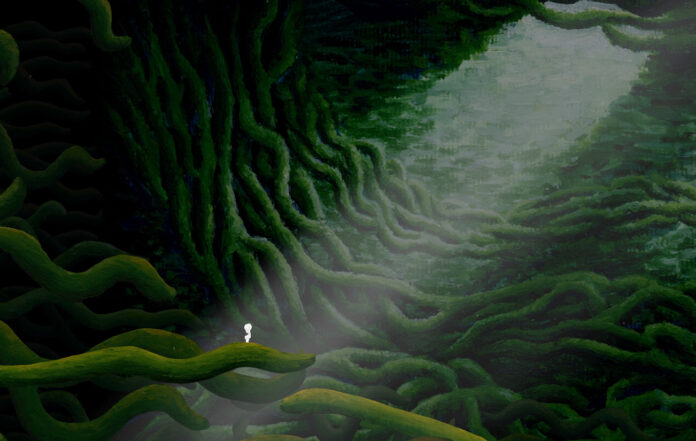As if developing a game by yourself wasn’t daunting enough, Pat Naoum decided to completely handpaint his debut game The Master’s Pupil. That alone took him hundreds of hours and the whole project now sits at 7 years. But the end is here, the game is out now on steam. “The painting really comes down to uniqueness”, he says. “Every man and his dog has made an indie game but no one has painted a game yet. It’s something different. A point of interest in the indie game sea.”
Naoum calls himself a jack of all trades, a master of none, so going solo on game development made a lot of sense. “For me it’s always been about the creative outlet. I wanted to try everything and work on the project that I wanted to make.” That project is a 2D side scrolling adventure set inside the eye of master painter Claude Monet. Quite an ambitious first game, but just the challenge Naoum was looking for. “Big goals are vital for me”, he says. “I love knowing that just a couple of hours here or there are going towards a much bigger plan. Like chipping away at some massive piece of marble. Creating that big piece of work is the motivation.”
Why did you become a solo developer?
“I’ve always loved making things, and the more mediums the project combines the better. I went through a Bachelor of Creative Arts, and then through Film School, all looking for bigger and better art forms. But I was also looking for something I could work on every day. Painting or art I could work on everyday, but I felt it wasn’t broad enough. Making films is also fantastic, but the ladder I could climb into that world, didn’t actually have much filmmaking in it. Perhaps if I were lucky I could get a couple of short films going per year, a couple of weekends of the actual process.”
“Then I played Braid and Limbo. I had grown up playing Nintendo 64, Playstation 2, a little Xbox 360, but through the end of high school and uni I drifted away from games. But a friend showed me Braid and Limbo towards the end of Film School and I finally realised ‘Wait a second, one person can make a game!?’ (I think Limbo was a team, but still). These were small versions of the AAA games I had played a lot of, but they were just as enjoyable.”
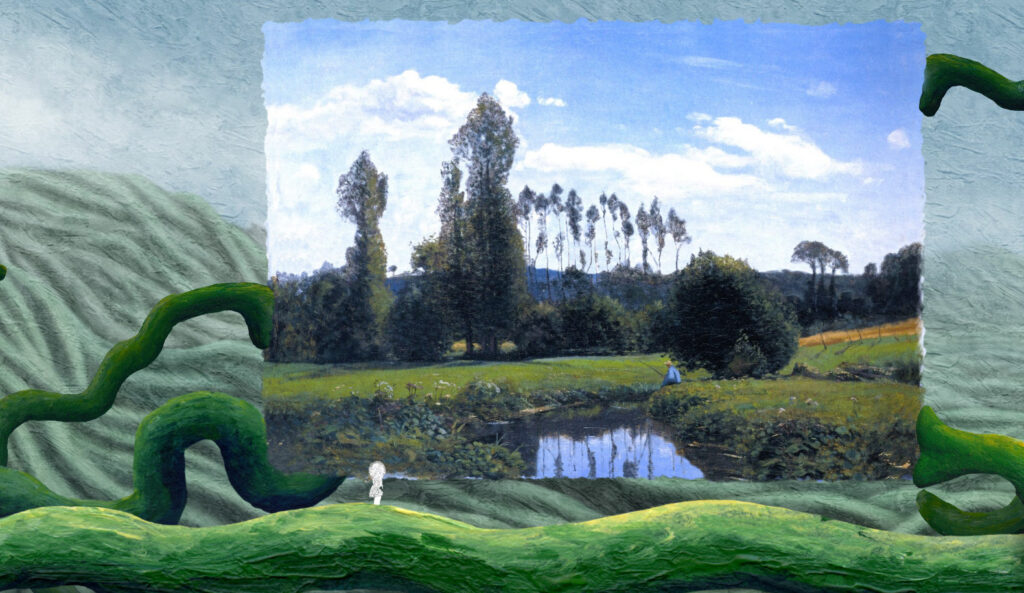
“Making games is different to making anything else. It’s the combination of art, coding, music, sound design, graphic design, writing, acting, animation, sculpture, and then at the end you can play it! Plus every day I get to sit down and work on a big project. And with solo development, I get to try everything. The Master’s Pupil being my first big game, I needed the time to learn at my own pace, and not be trying to keep up with a team.”
What are the biggest advantages of working solo?
“Broadly it’s the ability to work on my own project. If I wanted to work on games, I could have headed into the game industry looking for a job. Honestly I would have probably learnt faster and earned more money. But for me it’s always been about the creative outlet. I wanted to try everything and work on the project that I wanted to make.”
“Specifically though it’s about compromise. There’s a lot of compromise in game development outside of the creative choices. Will it run properly? Is this mechanic fun? Does that make sense to the player? So working solo you have fewer compromises to deal with. Getting to choose the overall project as well as its major choices was always important for me starting out. As I mentioned, this being my first game, I was learning not only how to game develop but also the language of game design. I feel now I’m a better game designer, because I had the time and space to work on it solo.”

“Schedule is also a big factor. Game development takes so long! I’ve been working as a freelance graphic designer since University, and about 4 years ago I decided to go part time to work on the game. That’s not something everyone can do. It’s a financial and time cost, a big life decision. So not only is it hard to make that choice, but it’s even harder to convince other people to come with you!”
And the biggest pitfalls?
“It’s the same as the advantages: no compromise and no schedule! It really does come down to ‘two heads are better than one’. I’m lucky that I’ve had a lot of talented friends around me to bounce ideas off. But not having another person committed to the project is a lot to carry. A lot of decisions to make, a lot of self doubt.”
“And then there’s also no one cracking the whip. There’s no one else’s time to manage. Another team member would have halved the workload of course, but I also think it would have sped up the development process as we tried to make our lives work around the project.”
What’s your creative process?
“For me there’s three main creative processes; the casual, the note taking, and the bum-on-seat work. Each one feeds into the next in that order. My friends and my family are wonderful, creative, and intelligent people. And I’ve milked them for all their worth! No, but seriously, discussing creative projects has always been part of my relationships. Asking and discussing general ideas about themes or concepts, ‘I’m thinking of making my eye game about Monet now… what do you reckon?’. It’s a small sample size, but it’s a good measurement of how interesting an idea can be. Plus just the act of talking out an idea generates a lot more ideas around it, as well as connecting them with other concepts. Eventually I did start asking these people to test the ideas in the game too.”
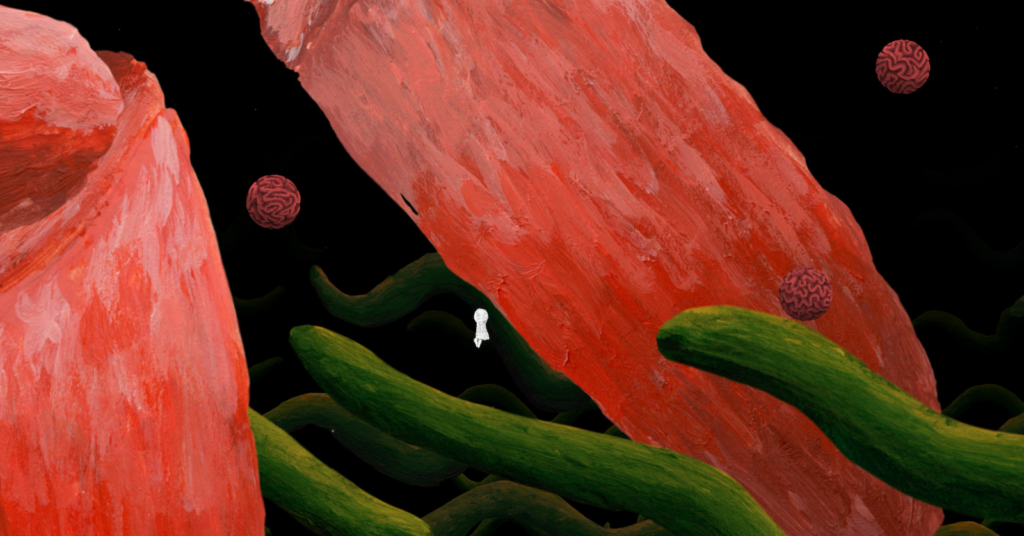
“I also take copious amounts of notes. It began because I have a terrible memory, if I have a hope of remembering something I have to write it down! I have long lists in my phone full of different ideas for games, and some of which have branched off and become their own lists full of specific details. Now not all of them would or should be games! But those notes create a basis of a project to build on, ideas being grouped and solidified. They might not all work at the end, but that doesn’t matter. The process of continually writing notes frees up your brain’s idle time. So next time I begin daydreaming, I’m not remembering my last idea, I’m building on it.”
Creativity doesn’t have to be magic, it can be a tool that you pick up and use.
“Then there’s the bum-on-seat work. Creativity doesn’t have to be magic, it can be a tool that you pick up and use. Most tasks require some kind of creativity, some more than others, so some creative tasks take longer. My creative process is the same as any other activity or work. I like to start with an overall plan or goal then break it into simple chunks to work on. But doing it actively, laying out information in different ways, seeing what makes connections. Early on in development in The Master’s Pupil I took an afternoon to map out the broad timeline of the game on my wall with sticky notes and lines of masking tape. It took a bit of work, and I had worked past it pretty quickly, but seeing it laid out like that generated more ideas.”
“With The Master’s Pupil nearly done, I’m looking forward to finally going through all my various notes for my next game, and seeing what I can work on. Which I’ll then chat about, which will feed into more ideas, and the cycle continues!”
How do you stay motivated through (years of) development?
“Try to enjoy the work. The day to day. As a kid I liked taking apart little gizmos or fixing things around the house. I still love to see how things work, and if they are broken I love the puzzle of how to fix it. Game Development is mostly fixing broken things! Or at least tweaking features over and over again. So finding enjoyment in that.”

“Big goals are vital for me. I love knowing that just a couple of hours here or there are going towards a much bigger plan. Like chipping away at some massive piece of marble. All advice for new game devs is to work on small projects, and make as many as you can. But I found the small stuff demotivating, as if that work was somehow wasted on smaller projects I cared little about. I probably should have followed their advice, as I’ve taken ages on just one project! Creating that big piece of work is the motivation.”
Will you ever work in a team or is it only solo for you?
“I would love to create a small team, and start to form a game company. Working solo is great, but I do like the collaboration. Brainstorming and bouncing up ideas and solutions. I’ve always been a jack of all trades, master of none, so it will eventually be great to work with some specialists. I found a little collaboration on The Master’s Pupil, working with my good friend and very talented composer Steven Schouten. We’ve always chatted about our projects together, communicated well, and so being able to work together was wonderful.”
GAME DEVELOPMENT IS MOSTLY FIXING BROKEN THINGS
“But to be honest it will come down to how The Master’s Pupil will sell. If I could pay for employees tomorrow, I would, but for now the solo dev works best. And if I get to keep making games, even in solo dev mode, that’d be great.”
The Master’s Pupil is set inside the eye of Monet. How did you come up with this unique setting?
“It comes back to the layering of ideas. The original concept was a game set inside an eye. I saw these amazing photos by Suren Manvelyan of extreme close ups of eyes. The irises kind of looked like landscapes, as if you were looking down into a valley of giant vines. That landscape could then sit between the real world and what a person experiences. A little surreal and conceptual, for sure. But I could have some flexibility combining what a person sees, and what happens to the player in that iris landscape.”
“The next idea layer was to have the game run over the lifespan of the person. The player starts at the edge of the iris, at the eye’s owner’s birth. Then runs towards the dark pit of the pupil which would be the person’s death. This way, the life of a person could be distilled into the player’s experience over the course of the play time.”
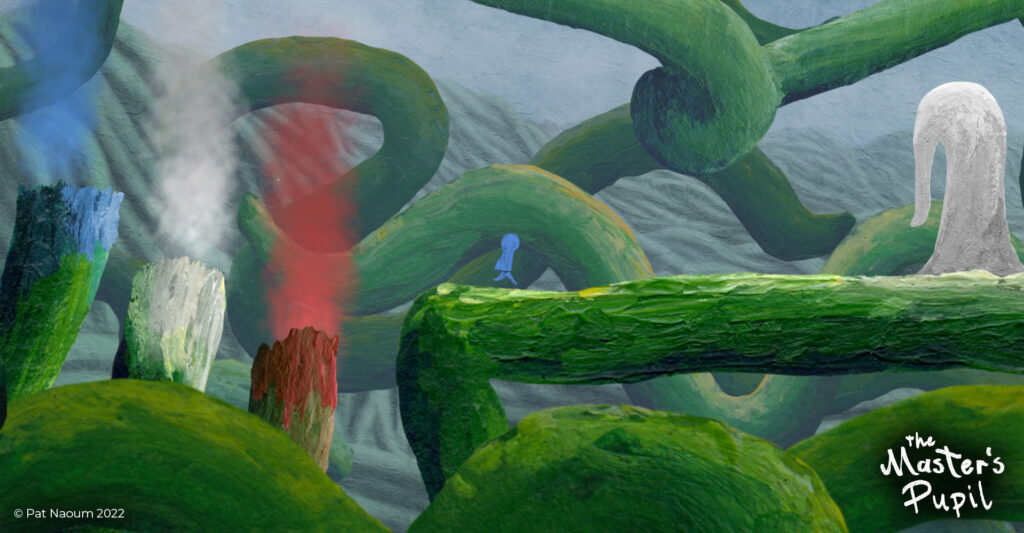
“This is where I laid out the masking tape game map. I tried to map out sections of someone’s life, with interesting times of history. I had options of living through the social revolutions of the 60s, and into the technical revolutions of the 80s and 90s. Or maybe earlier, someone living through the world wars?”
“Then there was also the idea of the game’s threat. My grandfather had macular degeneration in his old age, making him practically blind. Though it turns out, that has nothing to do with the iris. But cataracts sit above the iris and pupil, as a build up of calcification, maybe a giant cataract castle at the end? It would be a better ending than a dark pit of death!”
“And then I remembered Claude Monet, whom I loved when studying art at high school and uni. He had cataracts, and was one of the first high profile people to get eye surgery for it. He had an interesting life; he lived through wars, the death of two wives and a son, as well as the industrial revolution. He was also the turning point of Modernism in European art, the very start of shifting into abstract thinking. In fact, his painting ‘Impression, Sunrise’ gave birth to the name Impressionism. And hell, I know how to paint, I studied it for 3 years! So it was all these threads that came together slowly, but tied together so neatly.”
You spent hundreds of hours painting all the art assets in the game. Why did you go this route?
“Outside of all these concepts tying together, the painting also comes down to uniqueness. In the 15 years since Braid came out, every man and his dog has made an indie game. Especially an indie 2D side scroller puzzle game. But no one has hand painted a game yet. I knew if I could buckle down and put the hours into painting a game, it would stand out, become something different. A point of interest in the indie game sea.”
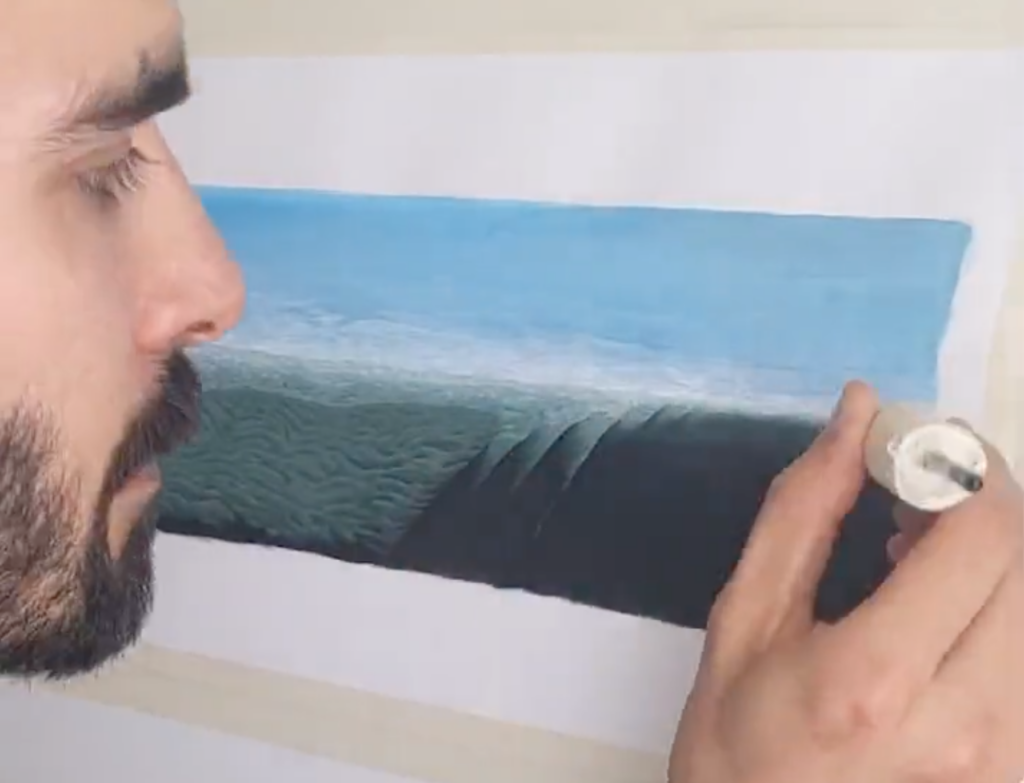
“Plus there’s so much texture and detail to hand made assets. Monet’s work really shows the beauty of just blobs of paint on a canvas. He obviously became the biggest inspiration for the game’s style. The game features 60 something of his paintings, so I had to try to keep up as best I could to blend his work into the general landscapes of the game. I’m still nowhere close to his skills, but I’ve attempted to capture the wonderful handmade messiness of his impressionist style.”
What’s the biggest lesson you learned from this project?
“That game development isn’t just making a cool game idea. It’s a combination of hard work, time, money, circumstance, marketing, and luck. Sure it helps if the game idea is cool, but that doesn’t make a game. The lesson I learned is commitment. Work out an idea, make sure it’s great, and commit to making it, and making it work in your life. It’s not about stubbornly holding onto a concept and making it a reality, it’s about finding a way to realistically make a great game.”
The toll on your mental health can be quite high as a solo developer. How do you deal with that?
“It’s interesting that so many devs say that. For me I think I might be the opposite! Not that I don’t get stressed but because game development has really supported my mental health. I’ve never really had a ‘real job’. I started to do freelance graphic design after Uni, and I’ve managed to keep at it ever since. The flexibility of my time, the variation of work, all kept the ‘earning money’ side of my life interesting. I think I would find a 9 to 5 job in a big company a toll on my mental health. But eventually even the freelance work became a grind, and I found focusing on a large creative project very satisfying and fulfilling.”
Once you make these big life decisions, the outcomes become more meaningful.
“Really the stresses have come later. I got a grant last year from Screen Australia. I threw my hat in, not really thinking I would actually get it, and it worked! So my little (kind of big) side project now is my full time job. Of course I’m extremely privileged and lucky to have been chosen. But now for the first time there is outside pressure that this needs to be finished, and needs to be good. Secondly, once you make these big life decisions, the outcomes become more meaningful. So the pressure of marketing also increases, I don’t think I realised its importance, and it’s been a big learning curve!”
“For me though mental health has always been about keeping up a routine: Work when everyone else is working. Eat well, sleep right, exercise often. Try and do something different on your weekends. And then when I inevitably do feel stressed, just breathe, remember ‘Hey man, this is your dream job’, and just try and enjoy the work.”

